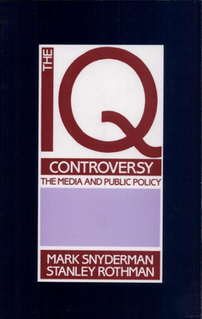Related Research Articles

Arthur Robert Jensen was an American psychologist and writer. He was a professor of educational psychology at the University of California, Berkeley. Jensen was known for his work in psychometrics and differential psychology, the study of how and why individuals differ behaviorally from one another.
The Flynn effect is the substantial and long-sustained increase in both fluid and crystallized intelligence test scores that were measured in many parts of the world over the 20th century. When intelligence quotient (IQ) tests are initially standardized using a sample of test-takers, by convention the average of the test results is set to 100 and their standard deviation is set to 15 or 16 IQ points. When IQ tests are revised, they are again standardized using a new sample of test-takers, usually born more recently than the first. Again, the average result is set to 100. However, when the new test subjects take the older tests, in almost every case their average scores are significantly above 100.

An intelligence quotient (IQ) is a total score derived from a set of standardized tests or subtests designed to assess human intelligence. The abbreviation "IQ" was coined by the psychologist William Stern for the German term Intelligenzquotient, his term for a scoring method for intelligence tests at University of Breslau he advocated in a 1912 book.
Discussions of race and intelligence – specifically, claims of differences in intelligence along racial lines – have appeared in both popular science and academic research since the modern concept of race was first introduced. With the inception of IQ testing in the early 20th century, differences in average test performance between racial groups were observed, though these differences have fluctuated and in many cases steadily decreased over time. Further complicating the issue, modern science has shown race to be a social construct rather than a biological reality, and intelligence has no undisputed definition. The validity of IQ testing as a metric for human intelligence is itself disputed. Today, the scientific consensus is that genetics does not explain differences in IQ test performance between groups, and that observed differences are therefore environmental in origin.

The theory of multiple intelligences proposes the differentiation of human intelligence into specific modalities of intelligence, rather than defining intelligence as a single, general ability. The theory has been criticized by mainstream psychology for its lack of empirical evidence, and its dependence on subjective judgement.
Emotional intelligence (EI) is most often defined as the ability to perceive, use, understand, manage, and handle emotions. People with high emotional intelligence can recognize their own emotions and those of others, use emotional information to guide thinking and behavior, discern between different feelings and label them appropriately, and adjust emotions to adapt to environments. Although the term first appeared in 1964, it gained popularity in the 1995 best-selling book Emotional Intelligence, written by science journalist Daniel Goleman. Goleman defined EI as the array of skills and characteristics that drive leadership performance.

Human intelligence is the intellectual capability of humans, which is marked by complex cognitive feats and high levels of motivation and self-awareness. High intelligence is associated with better outcomes in life.

Psychological testing is the administration of psychological tests. Psychological tests are administered by trained evaluators. A person's responses are evaluated according to carefully prescribed guidelines. Scores are thought to reflect individual or group differences in the construct the test purports to measure. The science behind psychological testing is psychometrics.
The Stanford–Binet Intelligence Scales is an individually administered intelligence test that was revised from the original Binet–Simon Scale by Alfred Binet and Theodore Simon. The Stanford–Binet Intelligence Scale is now in its fifth edition (SB5) and was released in 2003. It is a cognitive ability and intelligence test that is used to diagnose developmental or intellectual deficiencies in young children. The test measures five weighted factors and consists of both verbal and nonverbal subtests. The five factors being tested are knowledge, quantitative reasoning, visual-spatial processing, working memory, and fluid reasoning.
Intellectual giftedness is an intellectual ability significantly higher than average. It is a characteristic of children, variously defined, that motivates differences in school programming. It is thought to persist as a trait into adult life, with various consequences studied in longitudinal studies of giftedness over the last century. There is no generally agreed definition of giftedness for either children or adults, but most school placement decisions and most longitudinal studies over the course of individual lives have followed people with IQs in the top 2.5 percent of the population—that is, IQs above 130. Definitions of giftedness also vary across cultures.

Lewis Madison Terman was an American psychologist and author. He was noted as a pioneer in educational psychology in the early 20th century at the Stanford Graduate School of Education. He is best known for his revision of the Stanford–Binet Intelligence Scales and for initiating the longitudinal study of children with high IQs called the Genetic Studies of Genius. He was a prominent eugenicist and was a member of the Human Betterment Foundation. He also served as president of the American Psychological Association. A Review of General Psychology survey, published in 2002, ranked Terman as the 72nd most cited psychologist of the 20th century, in a tie with G. Stanley Hall.
High-functioning autism (HFA) is an autism classification where a person exhibits no intellectual disability, but may exhibit deficits in communication, emotion recognition and expression, and social interaction. HFA is not included in either the American Psychological Association's DSM-5 or the World Health Organization's ICD-10, neither of which subdivides autism based on intellectual capabilities.

The Kohs Block test, also known as the Kohs Block Design Test, is a performance test designed to be an IQ test. The test taker must, using 16 colored cubes, replicate the patterns displayed on a series of test cards. The design of the test was motivated by a belief that the test could easily be administered to persons with language or hearing disabilities.
Social intelligence is the capacity to know oneself and to know others. Social intelligence develops from experience with people and learning from success and failures in social settings. It is more commonly referred to as "tact", "common sense", or "street smarts".

The IQ Controversy, the Media and Public Policy is a book published by Smith College professor emeritus Stanley Rothman and Harvard researcher Mark Snyderman in 1988. Claiming to document liberal bias in media coverage of scientific findings regarding intelligence quotient (IQ), the book builds on a survey of the opinions of hundreds of North American psychologists, sociologists and educationalists conducted by the authors in 1984. The book also includes an analysis of the reporting on intelligence testing by the press and television in the US for the period 1969–1983, as well as an opinion poll of 207 journalists and 86 science editors about IQ testing.

IQ classification is the practice by IQ test publishers of labeling IQ score ranges with category names such as "superior" or "average".
The history of the race and intelligence controversy concerns the historical development of a debate about possible explanations of group differences encountered in the study of race and intelligence. Since the beginning of IQ testing around the time of World War I, there have been observed differences between the average scores of different population groups, and there have been debates over whether this is mainly due to environmental and cultural factors, or mainly due to some as yet undiscovered genetic factor, or whether such a dichotomy between environmental and genetic factors is the appropriate framing of the debate. Today, the scientific consensus is that genetics does not explain differences in IQ test performance between racial groups.

"How Much Can We Boost IQ and Achievement?" is a 1969 article by Arthur Jensen published in the Harvard Educational Review. It is among the most controversial in American psychology, and was largely responsible for initiating the current debate over race and intelligence.

Reuven Bar-On is an Israeli psychologist and one of the leading pioneers, theorists and researchers in emotional intelligence. Bar-On is thought to be the first to introduce the concept of an “EQ” to measure “emotional and social competence”, although the acronym was used earlier to describe ideas that were not associated with emotional intelligence per se. In the first copy of his doctoral dissertation, which was submitted in 1985, Bar-On proposed a quantitative approach to creating “an EQ analogous to an IQ score”.
Financial Quotient (FQ), sometimes also referred as financial intelligence (FI), financial intelligence quotient (FiQ) or financial IQ, is the ability to obtain and manage one's wealth by understanding how money works. Like emotional quotient (EQ), FQ derived its name from IQ.
References
- ↑ Feinberg, Harry (November 1941). "IQ correlated with EQ". Journal of Educational Psychology. 32 (8): 617–623. doi:10.1037/h0057239.[ dead link ]
- ↑ Salopek, Thomas; Salopek, Thomas F. (1971). "Achievement and intelligence in primary and elementary classes for the educable mentally retarded". Journal of School Psychology. 9 (2): 150–156. doi:10.1016/0022-4405(71)90008-2.
- ↑ Victor, Maurice; Agamanolis, Dimitri (Summer 1990). "Amnesia due to Lesions Confined to the Hippocampus: A Clinical-Pathologic Study". Journal of Cognitive Neuroscience. 2 (3): 246–257. doi:10.1162/jocn.1990.2.3.246. PMID 23972048.
- ↑ Gregory, Chester (2009). Fundamentals of Educational Measurement with the Elements of Statistical Method. BiblioBazaar, LLC, 2009. pp. 191/404. ISBN 978-0-559-90210-9.
- ↑ Sidhu, Kulbir (2005). New Approach To Measurement And Evaluation. Sterling Publishers Pvt. Ltd. ISBN 978-81-207-2827-1.